Send us a message
We would like to learn more about your challenges and to understand how we can support you.
Get in touch.
Send us a message and we’ll get
back to you within 48 hours.
Alternatively, email
hello@shiifttraining.com
When it comes to employee training and development, businesses face a key decision: bespoke training versus off-the-shelf training.
This article explains the difference between both training solution options and examines five reasons why bespoke training is more effective than off-the-shelf options. We will cover relevance, engagement, flexibility and scalability, long-term impact, and competitive advantage, showing how customized programs deliver better results for both employees and the organization.
Bespoke training is a learning program specifically designed to meet the unique needs of a company and its employees.
Unlike off-the-shelf courses, which offer generic content for a broad audience, bespoke training is tailored to reflect a company’s processes, goals, culture, and compliance requirements.
Bespoke training is usually more expensive upfront, but more relevant and easier to scale because the company will own the training outright and be able to deploy it as they wish, for as long as they like (short term cost).
Off-the-shelf training refers to pre-made learning programs designed for a broad audience, rather than tailored to a specific company or workforce.
These courses cover general topics and standard industry practices using a one-size-fits-all approach, offering a convenient and quick solution for employee training.
Off-the-shelf training is usually more beneficial for training providers, since they own the training solutions, they only need to produce the training content once and can sell the same training solutions to hundreds of different companies, often by continuous subscription per user (long-term costs).
One of the greatest strengths of bespoke training is its direct alignment with your company’s objectives, processes, and challenges.
Addresses the unique skill gaps of each role or department and uses scenarios drawn directly from the actual workplace, ensuring employees gain knowledge and experience they can immediately apply on the job. A great example of a training method that takes advantage of relevancy and shows powerful results are Learning From Incidents (LFI) training videos which usually uses real-life incident examples directly from the workplace’s past incidents, where employees are doing the same work processes.
Off-the-shelf training often include irrelevant content and use examples that are not specific to your company, which can limit engagement and reduce the practical value of the learning. Imagine working in a chemical plant and taking an off-the-shelf PPE training course, and the training video shows workers in a generic lab using equipment and protective gear that your company doesn’t use, so much of the guidance doesn’t apply to your actual workplace or safety requirements.
By embedding real-world company scenarios, bespoke training makes learning actionable and instantly applicable, without workers needing to spend time trying to understand how it actually connects to what they will be doing in their work.
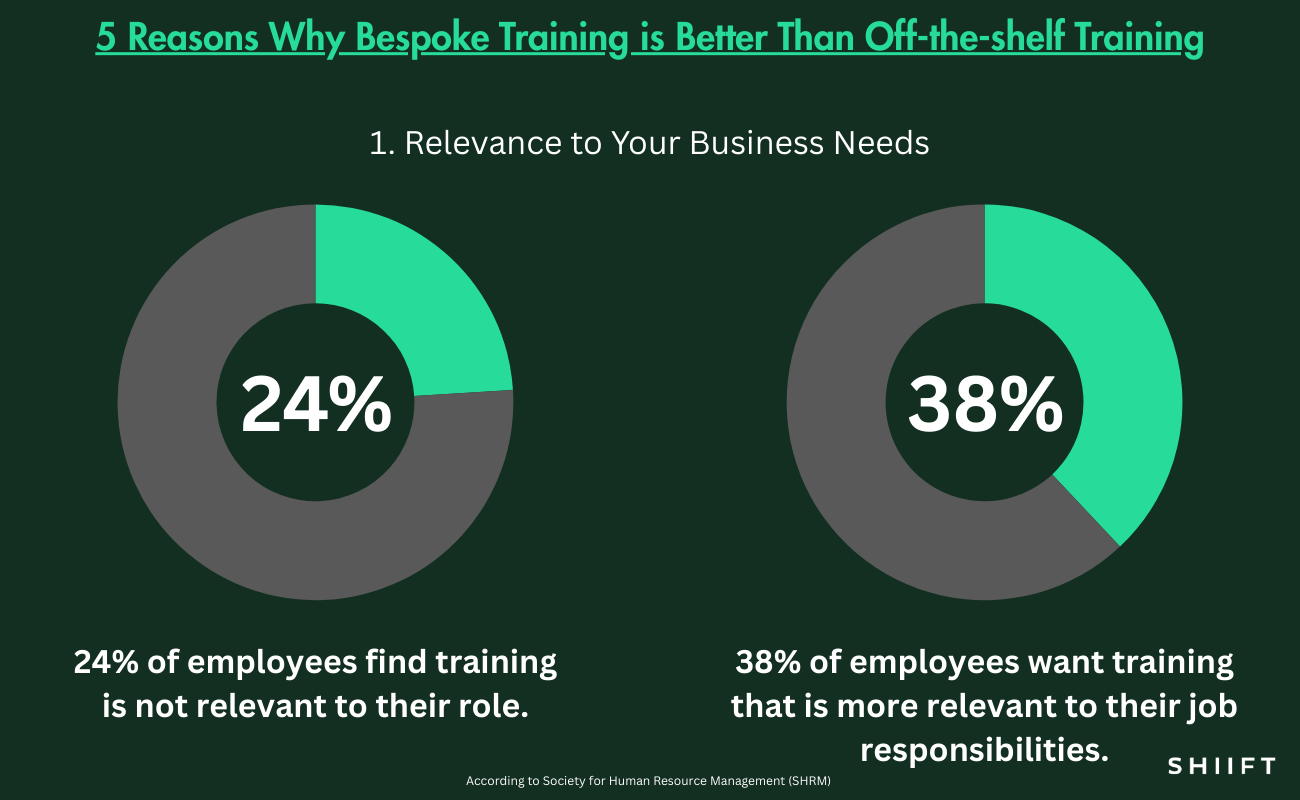
Employee engagement is a major factor in the effectiveness of any training program, which is boosted by bespoke training.
Bespoke training is specifically designed to engage employees by reflecting their real responsibilities. Role-specific scenarios and relevant examples make learning meaningful, which increases retention and motivates employees to apply their knowledge immediately. When learners are actively involved and can relate the content to their day-to-day tasks, retention improves significantly.
Off-the-shelf training often struggles to engage employees because it is generic and not tailored to their specific roles. Learners may skip sections or lose interest, leading to lower retention and limited application of skills in the workplace.
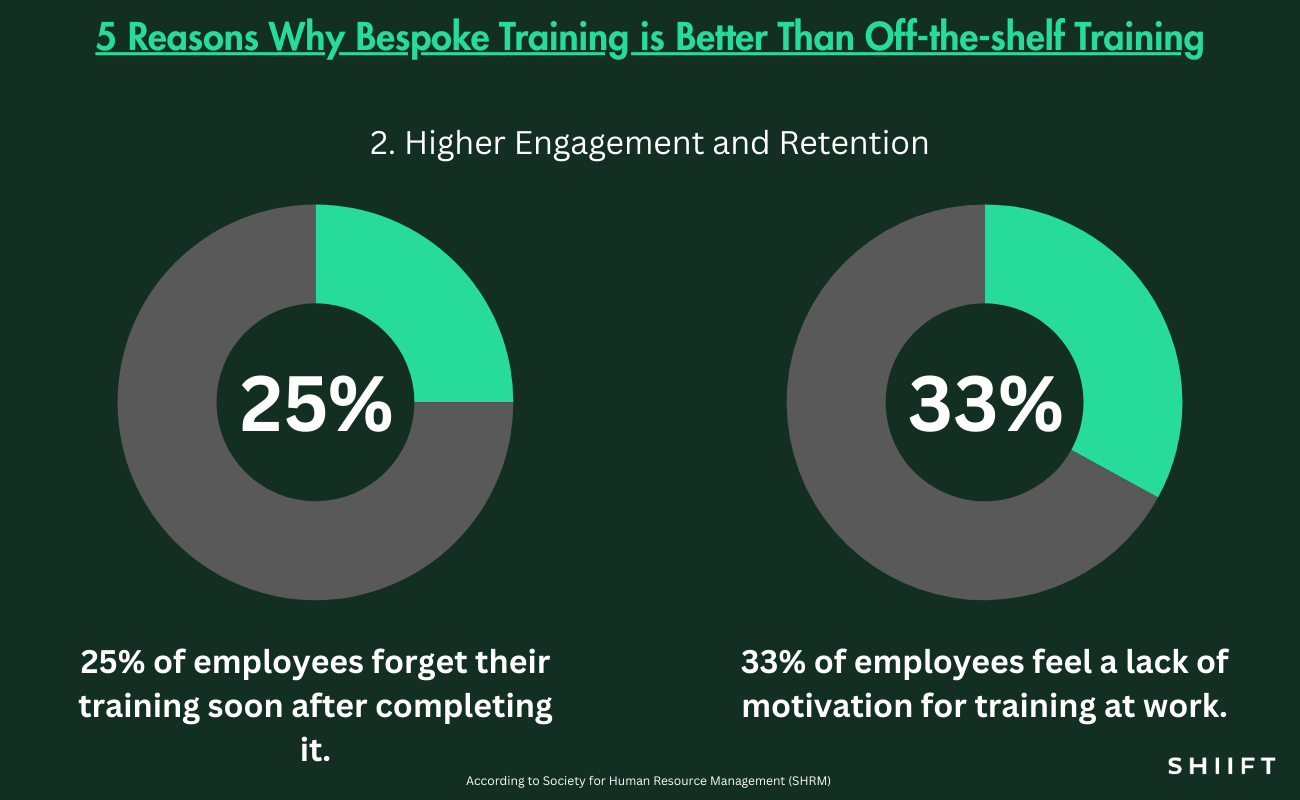
With bespoke training, organizations grow and change, and their training programs need to adapt accordingly.
Bespoke training can be adjusted to accommodate new teams, departments, or locations without requiring a complete redesign. Updates to reflect changes in processes or policies can be implemented quickly, maintaining relevance and consistency across the workforce. On top of this, it’s cheaper to scale bespoke training, as long as you own the training you can provide it any number of employees you desire, without any additional cost per employee.
Training that can grow with the company ensures consistent knowledge, addresses emerging challenges, and supports new roles or processes. Flexible programs reduce the need for repeated or redundant training while keeping employees aligned with company goals.
Off-the-shelf programs are fixed and inflexible. Scaling to larger workforces can be expensive and updating content often requires vendor involvement. As a result, these programs don’t meet evolving business needs effectively.
When a company uses inflexible training programs, they’ll have to search often for something that’s as relevant to their company as possible, but it’s impossible to find something that matches your all workplace’s requirements perfectly without bespoke training. Even if you request involvement from a vendor, there’s often a limit to how much they can change to the training and ends up costing money better spent on a fully custom training solution that covers all your needs from the get-go.
You might even end up paying multiple different subscriptions where half the content isn’t used in any of them, just so they add up to cover your training needs.
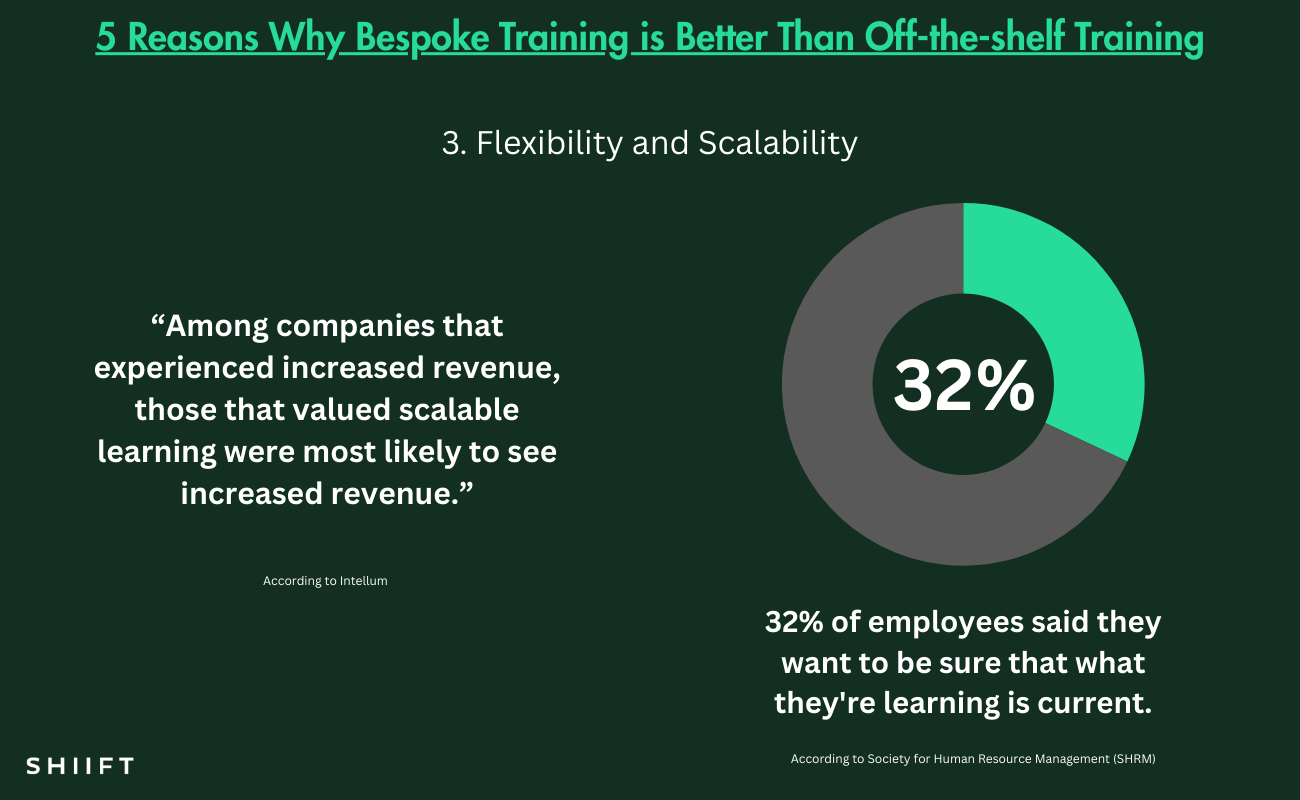
Investing in training is only worthwhile if it produces measurable results and lasting benefits for both employees and the organization.
Bespoke training addresses specific skill gaps and reduces errors, accidents, or compliance risks that will have an actual effect on a company’s current training gaps, directly resolving those issues. By targeting the areas that matter most, it improves employee performance, efficiency, and overall productivity. Also, because the content is relevant and tailored, it fosters higher engagement and knowledge retention, creating measurable improvements in both individual and team performance. Over time, these benefits translate into a clear return on investment.
Off-the-shelf training may leave gaps in employee knowledge and skills because it is generic. It can result in continued errors, lower efficiency, and limited measurable outcomes, which reduces its long-term value and effectiveness. Because the content is not tailored to your organization’s processes or objectives, it is difficult to measure its real impact, limiting the long-term value of the investment and often requiring supplemental training to achieve desired outcomes.
Also, with off-the-shelf training you’re often paying for a large library of training content, maybe a part of it will be useful but still not perfect, and the rest of the content will be useless but still being paid for for no reason. With bespoke training, you’re paying for what you need without extra baggage.
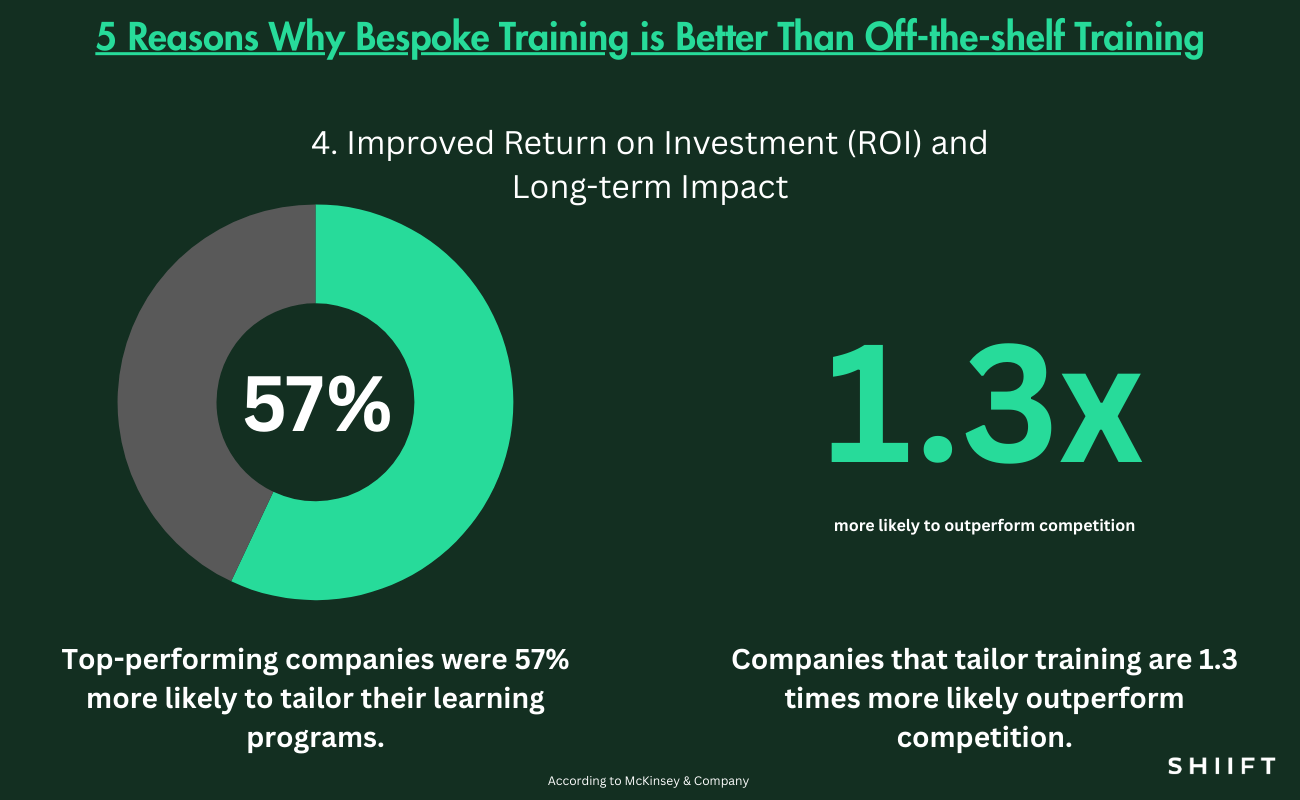
Investing in training is only worthwhile if it produces measurable results and lasting benefits for both employees and the organization.
Bespoke training reflects a company’s specific culture, values, and workflows, helping employees understand how their roles contribute to broader organizational goals. They use the same kind of language that’s consistent with their corporate or safety leadership teams, they also use visuals with company branding, logos and colors. This alignment strengthens engagement, boosts morale, and builds loyalty.
With all the training tied in and being fully owned by the company, it unites employees as one big team, and helps them feel recognized and supported in their professional growth, which increases retention and reduces turnover-related costs.
Off-the-shelf training lacks connection to a company’s unique culture and values. While it can teach general skills, it rarely fosters a sense of belonging or aligns employees with the organization’s mission. As a result, staff may complete training without increased engagement or sense of belonging, causing the company to miss the opportunity to reduce turnover and strengthen its internal culture.
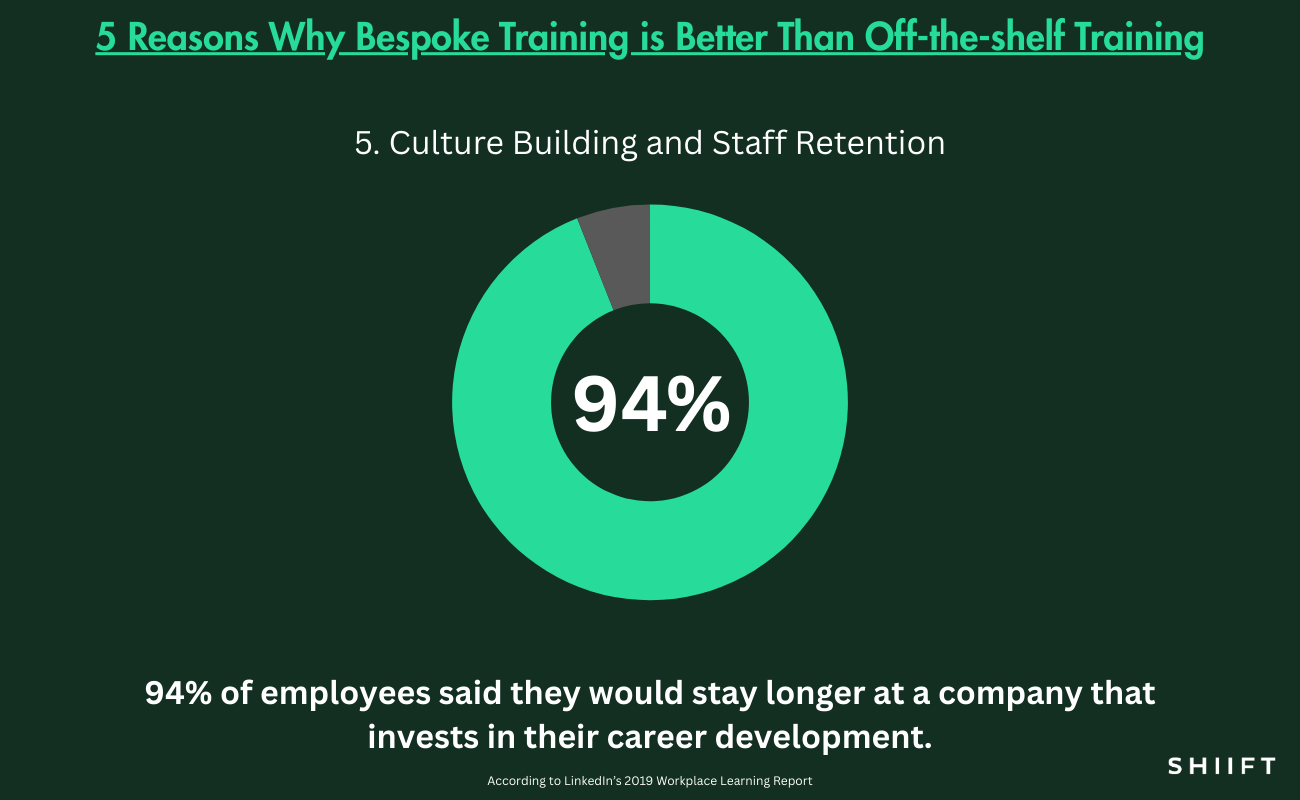
Picture two different energy companies, each watching a safety video in separate training sessions to onboard employees. Company A has a video using off-the-shelf training, while Company B uses bespoke training and reaps the benefits.
| Company A (Uses off-the-shelf training) | Company B (Uses bespoke training) | |
| Start of video: | “This video will teach you 8 life-saving rules.” | “Welcome to Company B! This video will teach you all about Company B’s 8 life-saving rules” |
| Characters in Video: | Wearing generic clothing and equipment, that don’t match fully what Company A actually wears. | Wearing Company B branded overalls, with logo attached to safety helmet, and fully matches what Company B staff wear. |
| Workplace setting | Generic industrial site, with equipment and layout that look nothing like Company A’s facilities. | Video is set in Company B’s actual work environment, with recognizable locations and familiar equipment. |
| Language and tone | Uses broad industry terminology without reference to Company A’s culture or values. | Uses Company B’s internal language, slogans, and values, reinforcing the company’s unique identity. |
| Scenario realism | Generic situations not always representative of actual job challenges. | Real-life Company B scenarios are used, making the training highly relatable, sometimes even based on past incidents. |
| Company rituals or practices | Not shown; generic compliance focus. | Company-specific rituals, safety check routines, and teamwork protocols are highlighted. |
| Impact on culture | Employees see it as generic content, with little connection to company identity and more focused on general rules used in the industry, | Employees immediately recognize company values and team practices, reinforcing culture. Explicitly reinforces Company B’s mission, values, and expected team behaviors. |
| Impact on staff retention | Training completion does not significantly influence loyalty or attachment. | Reflecting company culture and teamwork in training fosters pride and loyalty, improving retention. |
Here are 6 examples from SHIIFT’s portfolio demonstrating how bespoke training solutions have been taken advantage of by our clients.
Client: ADNOC
Training Format: eLearning
This bespoke eLearning was designed fully with ADNOC in mind and designed based on their safety rules and what their workers would experience, branded with their logo and colors throughout.
Client: James Hardie
Training Format: Online Simulation App (accessed via their LMS)
This bespoke training uses click-based controls only to suit James Hardie’s audience, we also incorporated their branded building products and logo throughout the training simulation, reinforcing familiarity for their employees and fostering a stronger sense of ownership and pride in their workplace safety.
Client: Schneider National
Training Format: VR Training
This custom VR driver training was created on behalf of Schneider, to add engaging training formats to their driver training program. The training is based on their “Five S’s” Set Up, Signal, Slow Down, Survey, and Steer.
Client: Nass Corporation
Training Format: 3D Animation
This bespoke training video predominantly used stylized 3D animation, but to kick off the induction video it began with a short live-action interview from their chairman, setting the tone and showing that safety was a leadership priority.
Client: Nutrien Ag Solutions
Training Format: VR Training
Nutrien’s complex process of transferring the hazardous ammonia safely consists of 60+ steps, that are unique to their equipment and safety policies. This training needed to be fully custom to accurately train Nutrien’s engineers to operate the equipment and complete ammonia transfer safely.
Client: TotalEnergies
Training Format: Live-action Video
Another fully custom training video example, but this one was fully live-action. It’s a short and sweet country induction video that takes workers relocating from overseas to Suriname, showing them the culture of Suriname, TotalEnergies office and company culture, and more.
While off-the-shelf training can provide quick access to generic learning, it rarely delivers the depth, alignment, and long-term impact that modern organisations need. Bespoke training, on the other hand, is built around your company’s unique goals, processes, and people. Clear to see from the comparisons above, bespoke training is more relevant, engaging, flexible, cost-effective, and strategically powerful.
More importantly, bespoke training enables companies to strengthen their competitive edge in a rapidly changing market. For organisations committed to growth and talent development, investing in bespoke training creates a lasting advantage.
Take this article for example, we used SHIIFT Training branding and colors all around designed to match our brand, but if we used only stock images, we’d never find the perfect fit that communicates exactly what we aim to communicate, which is that bespoke training comes with the most benefits.
If you’re interested in bespoke training solutions, contact SHIIFT with the link below or check out more of our bespoke training case studies!
Deliver next generation training. Get in touch.
Email us at hello@shiifttraining.com or send
us a message and we’ll be in touch within 48hrs.